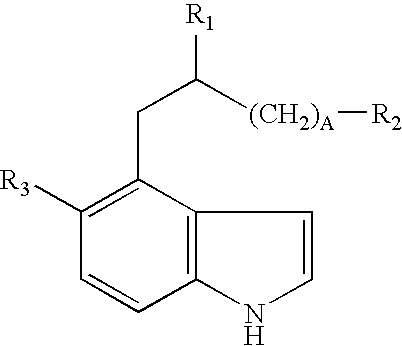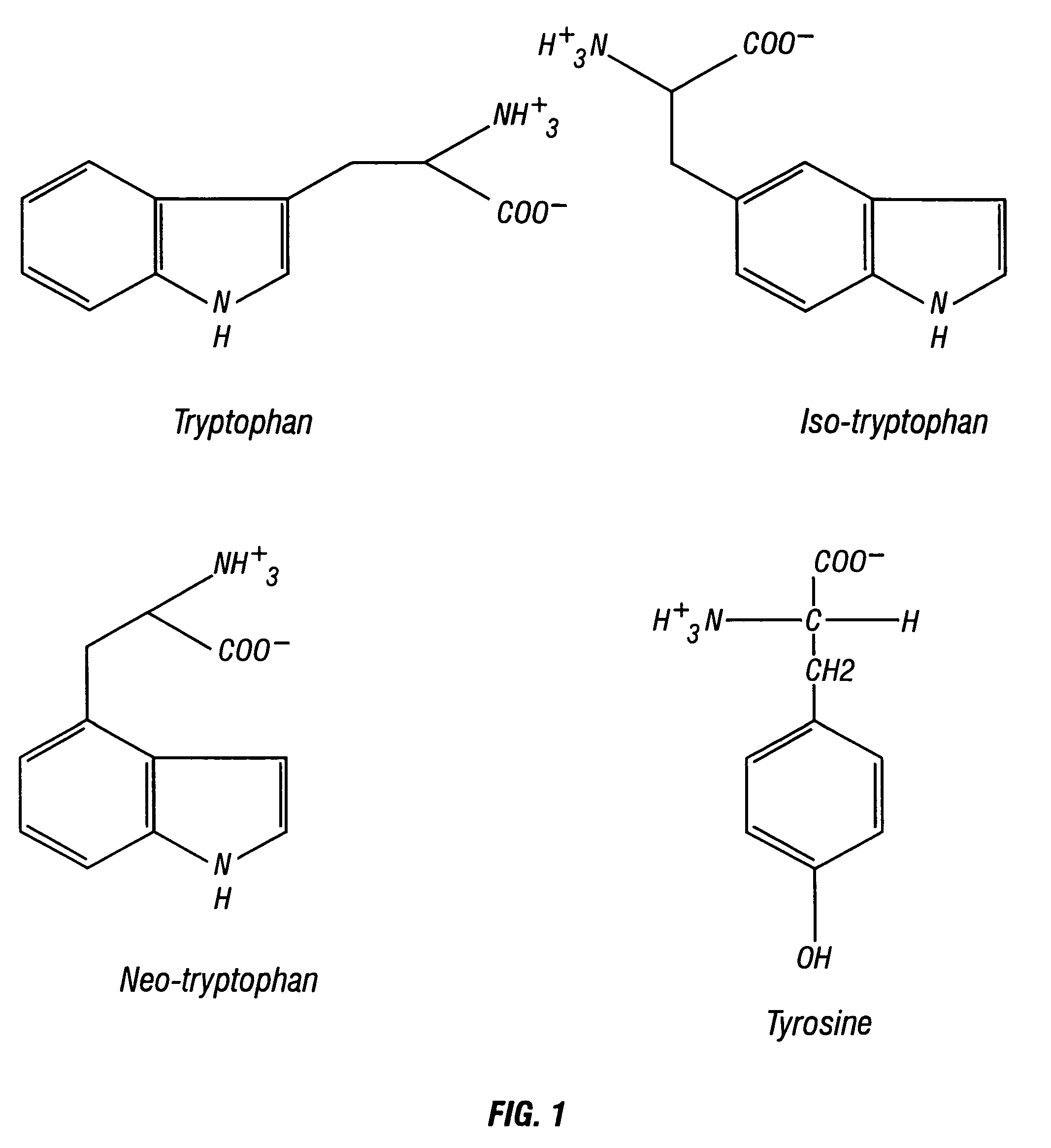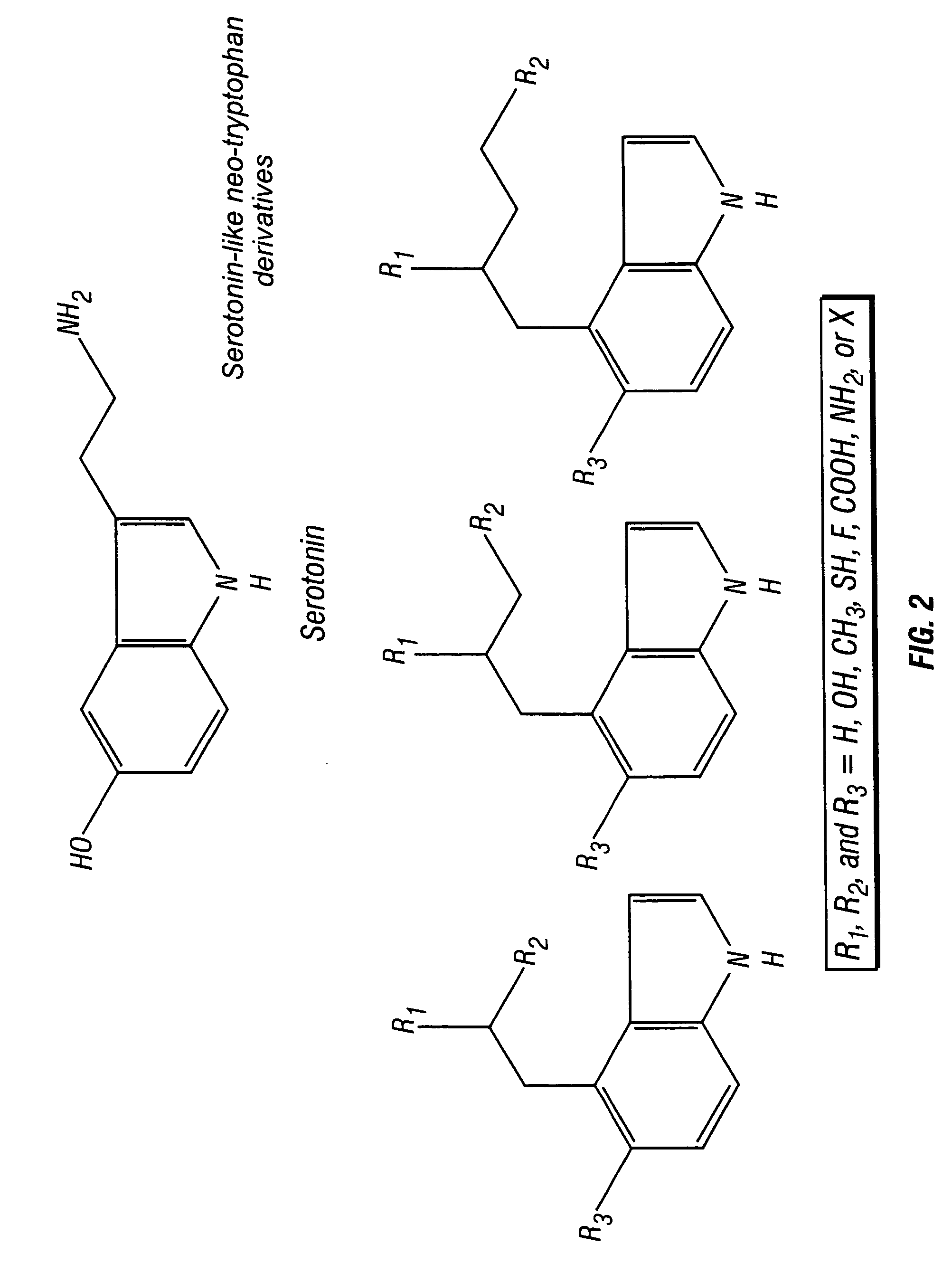Neo-tryptophan
a technology of neotryptophan and amino acid, which is applied in the direction of enkephalin, drug composition, peptide/protein ingredients, etc., can solve the problem of poor blood brain barrier
- Summary
- Abstract
- Description
- Claims
- Application Information
AI Technical Summary
Benefits of technology
Problems solved by technology
Method used
Image
Examples
example 1
Synthesis of Neo-Tryptophan and Neo-Tryptophan-Containing Polypeptides
[0052] D- and L-neo-tryptophan were synthesized according to the schemes depicted in FIGS. 3 and 4. Polypeptides containing neo-tryptophan were synthesized as described elsewhere using the neo-tryptophan amino acids when appropriate (Morbeck D E et al., In: Methods: A Companion to Methods in Enzymology 6:191-200, Academic Press Inc., New York (1993)). Briefly, polypeptides were synthesized using Fmoc chemistry with t-butyl-protected side chains, either individually on automated polypeptide synthesizers (ABI 430A or 431A) or simultaneously on a multiple polypeptide synthesizer (ACT350, Advanced Chemtech, Louisville, Ky.). Protocols concerning activation coupling times, amino acid dissolution, coupling solvents, and synthesis scale were followed according to the manufacturer's instructions. All polypeptides were purified by reverse-phase HPLC using a C18 column (2.2×25 cm; Vydac, Hesperia, Calif.) in 0.1% TFA / water...
example 2
Neurotensin Receptor Binding Properties of Neo-Tryptophan-Containing Polypeptides
[0069] CHO-K1 cells were stably transfected with nucleic acid encoding either the human NTR1 or the rat NTR1, and cultured in 150 mm petri plates with 35 mL of Dulbecco-modified Eagle's medium containing 100 μM minimal essential medium nonessential amino acids (GIBCO) supplemented with 5% (v / v) FetalClone II bovine serum product (Hyclone Labs, Logan, Utah). CHO cells (subculture 9-19) were harvested at confluency. Briefly, the medium from each plate was removed by aspiration, and the cells washed with 6 mL of 50 mM Tris-HCl (pH 7.4) and resuspended in 5-10 mL of Tris-HCl by scraping the cells with a rubber spatula. The resuspended cells were placed into a centrifuge tube and collected by centrifugation at 300× g for five minutes at 4° C. in a GPR centrifuge (Beckman Instruments, Fullerton, Calif.). The cellular pellet (in 50 mM Tris-HCl, 1 mM EDTA, pH 7.4) was stored at −180° C. until radioligand bindi...
example 3
PI Turnover Properties of Neo-Tryptophan-Containing Polypeptides
[0078] To measure PI turnover, intact CHO-K1 cells were harvested at about 80% confluency. Cells were detached from the petri plates by removal of culture medium followed by incubation of the cellular monolayer for 20 minutes at 37° C. with gentle shaking in a modified Puck's D1 solution containing 2 mM EGTA. The details of assaying the relative changes in PI turnover in intact cells using a radioactively labeled precursor was described elsewhere (Pfenning and Richelson, In: Methods in Neurotransmitter Receptor Analysis Eds: Yamamura H I, S J Enna and M J Kuhar, pp.147-175, Raven Press, New York (1990)). Briefly, intact CHO cells were prelabeled with D-myo-[3H]inositol (18.3 Ci / mmol) in the presence of lithium chloride (final concentration, 10 mM). Cells were then stimulated with NT or the appropriate NT analog, and the amount of [3H]inositol 1-phosphate ([3H]IP1) produced by the cells isolated chromatographically on D...
PUM
| Property | Measurement | Unit |
|---|---|---|
| time | aaaaa | aaaaa |
| hydrophobic | aaaaa | aaaaa |
| blood brain barrier permeability | aaaaa | aaaaa |
Abstract
Description
Claims
Application Information
 Login to View More
Login to View More - R&D
- Intellectual Property
- Life Sciences
- Materials
- Tech Scout
- Unparalleled Data Quality
- Higher Quality Content
- 60% Fewer Hallucinations
Browse by: Latest US Patents, China's latest patents, Technical Efficacy Thesaurus, Application Domain, Technology Topic, Popular Technical Reports.
© 2025 PatSnap. All rights reserved.Legal|Privacy policy|Modern Slavery Act Transparency Statement|Sitemap|About US| Contact US: help@patsnap.com



